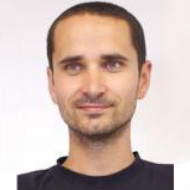


Speech Title: Computational study of cell collision rates in periodic obstacle arrays
Abstract: Computational modelling belongs to strong and effective tools helping to design a mi-
crofluidic device with predefined purpose. We have developed a computational model which
captures the bio-mechanical processes inside microfluidic devices including cell deformation,
fluid flow, mutual cell-cell and cell-fluid interactions. Using this model, we are able to model
and simulate different devices such as periodic obstacle arrays, cell retention structures, dif-
ferent T- or Y-junctions, cell isolation channels, etc.
The model consists of two parts, one based on lattice-Boltzmann method describing the
fluid dynamics, and second based on immersed boundary method describing the cell by dis-
cretization of its membrane. Using spring networks, we model the elasticity of the cell that
is calibrated according to cell stretching experiments. Two parts of the model are coupled so
that fluid influences the cells and vice versa.
During the simulation we have complete information about the cell membrane geometry
and about the surrounding fluid. Therefore, we can compute a wide range of physical and
mechanical quantities including local membrane stress, shear stress at the cells boundary, cell
velocity, its deformation index. We are able to see the cells behavior by letting the cell pass
various obstacles or retention structures. With the latest developments of the model, we are
able to simulate cell adhesion to functionalized surfaces, which enables modelling of devices
for circulating tumor cells isolation.
Parallel implementation of the model allows us to simulate suspensions of thousands of
cells which gives statistically significant information about global behavior of the suspension
and thus we can model rheological properties of the suspension. The model is implemented
as Object-in-fluid module of open source scientific software package ESPResSo. The detailed
documentation provides guidance for biologist with basic interest in modelling.
We have used this model for determination of collision rates for rare cell capture in periodic
obstacle arrays. Apart from previous studies where no mutual cell collisions were taken into
account, we employ the approach with cell-cell interactions. This allows to model situations
with cell suspension with higher hematocrit. We demonstrate that even with low cell-to-fluid
ratio, the optimal geometry of the obstacle array significantly differs from that for dilute
suspensions. More specifically, we have discovered a hematocrit threshold, above which the
cells do not enter the collision mode.